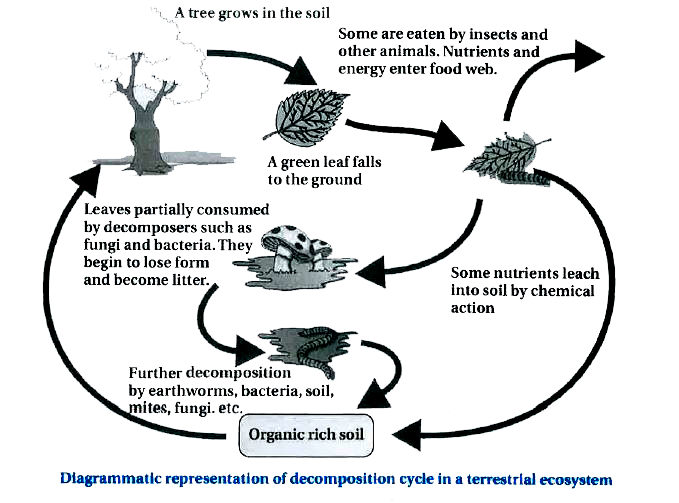Mention various steps included in the process of decomposition.
The important steps in the process of decomposition are fragmentations, leaching, catabolism, humification and mineralisation.
(i) Fragmentation : Detritivores (e.g., earthworm) breakdown detritus into smaller particles. This process is called fragmentation.

Diagrammatic representation of decomposition cycle in a terrestrial ecosystem
(ii) Leaching : By the process of leaching, water soluble inorganic nutrients go down into the soil horizon and get precipitated as unavailable salts.
(iii) Catabolism : Bacterial and fungal enzymes degrade detritus into simpler inorganic substances. This process is called catabolism.
(iv) Humification : Humification and mineralization occur during decomposition in the soil. Humification leads to accumulation of a dark coloured amorphous substance called humus that is highly resistant to microbial action and undergoes decomposition at an extremely slow rate. Being colloidal in nature it serves as a reservoir of nutrients.
(v) Mineralization : The humus is further degraded by some microbes and release of inorganic nutrients occur by the process known as mineralization.
Decomposition is largely an oxygen requiring process.
The rate of decomposition is controlled by chemical composition of detritus and climatic factors.
In a particular climatic condition, decomposition rate is slower if detritus is rich in lignin and chitin and quicker, if detritus is rich in nitrogen and water soluble substances like sugars.
Temperature and soil moisture are the most important climatic factors that regulate decomposition through their effects on the activities of soil microbes.
Warm and moist environment favour decomposition whereas low temperature and anaerobiosis inhibit decomposition resulting in build up of organic materials.
Topper's Solved these Questions
- ECOSYSTEMBOOK - KUMAR PRAKASHANCHAPTER - ECOSYSTEMEXERCISE - SECTION - B (DIFFERENCE/SCIENTIFIC REASONS)
6 Videos
- ECOSYSTEMBOOK - KUMAR PRAKASHANCHAPTER - ECOSYSTEMEXERCISE - SECTION - C (OBJECTIVE QUESTIONS - ANSWERS)
10 Videos
- BOARD QUESTION PAPER MARCH -2020BOOK - KUMAR PRAKASHANCHAPTER - BOARD QUESTION PAPER MARCH -2020EXERCISE - Part-B (Section-C)
5 Videos
- ENVIRONMENTAL ISSUESBOOK - KUMAR PRAKASHANCHAPTER - ENVIRONMENTAL ISSUESEXERCISE - Section - F (Multiple Choice Question (MCQs))(MCQs ASKED IN COMPETITIVE EXAM)
22 Videos
Similar Questions
Knowledge Check
select the correct set of steps involved in the process of decomposition. (a) stratification, (b) catabolism, (c) fragmentation, (d) mineralization, (e) leaching
A(a), (b) and (d)B(a), (c) and (e)Call except (e)Dall except (a)The important steps in the process of decomposition are
AFragmentation and mineralizationBLeaching and catabolismCHumification and mineralizationDAll of theseThe important steps in the process of decomposition are
Afragmentation and mineralizationBleaching and catabolismChumification and mineralizationDall of these.
Name the important steps in the process of decomposition.
View SolutionExplain the various steps involves in the process of controlling.
OR What is meant by controlling ? Describe the steps in the process of controlling
OR 'Controlling is a systematic process involving a series of steps'. State the steps involved in the process.
View SolutionDescribe briefly the steps in the process of controlling
or
Controlling is a systematic process involving a series of steps. State the steps involved in the process.
or
Explain the various steps involved in the process of controlling
or
Explain the prcoess of controlling
View Solution(a) Photosynthesis converts energy X into energy Y. What are X and Y ?
(b) State the various steps involved in the process of photosynthesis
View SolutionMention the issues included in the concept of development.
View Solution
